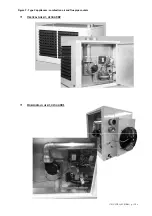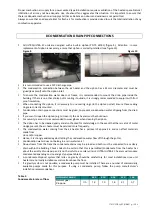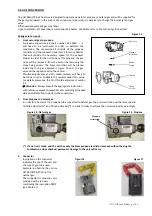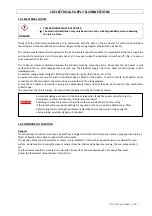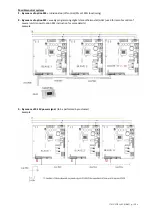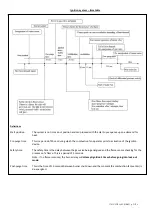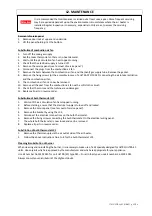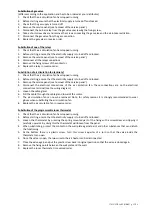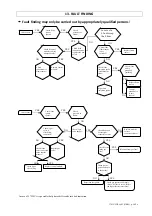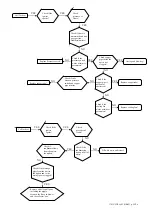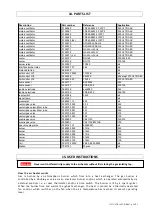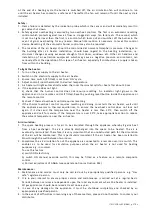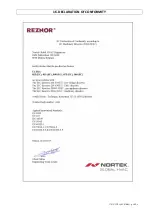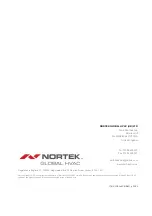
1701ULTRA(EC)GBEN, p. 27/29
At
the
end
of
a
heating
cycle
the
burner
is
switched
off,
the
air
circulation
fan
will
continue
to
run
until
the
air
heater
has
cooled
to
a
safe
level.
Thereafter
the
fan
will
remain
off
until
the
next
cycle
is
initiated.
Safety:
1.
Flame
failure
is
detected
by
the
ionisation
probe
which
is
the
sensor
and
will
immediately
result
in
gas
valve
shut
down.
2.
Safety
against
overheating
is
assured
by
two
overheat
controls.
The
first
is
an
automatic
resetting
control
which
protects
against
low
air
flow
i.e.
clogged
air
ways,
fan
failure
etc.
The
second,
which
is
set
to
a
higher
level
than
the
first,
is
a
control
which
locks
out
and
switches
off
the
burner
in
the
event
of
gross
overheating
for
any
reason.
Manual
intervention
is
necessary
to
reset
this
control
device.
Resetting
of
the
automatic
burner
control
may
also
be
required.
3.
The
location
of
the
air
heater
should
be
maintained
at
normal
atmospheric
pressure.
Changes
to
the
building
after
air
heater
installation,
should
have
regard
to
the
heating
installation,
i.e.
structural
changes
causing
excessive
draughts
from
doors,
windows
etc.
Other
air
handlers
and
installation
of
air
extraction
equipment
which
may
cause
a
negative
pressure
environment,
can
seriously
affect
the
operation
of
this
type
of
air
heater,
especially
if
combustion
air
supply
is
taken
from
within
the
building.
To
light
the
heater:
1.
Turn
on
the
gas
supply
to
the
air
heater.
2.
Switch
on
the
electricity
supply
to
the
air
heater.
3.
Ensure
time
switch
(if
fitted)
is
set
to
an
'ON'
cycle.
4.
Adjust
control/room
thermostat
to
desired
temperature.
5.
Air
heater
will
light
automatically
when
the
room
thermostat
calls
for
heat
after
about
30
sec.
6.
If
the
appliance
does
not
light:
a)
check
that
the
burner
control
does
not
require
resetting.
An
indicator
light
glows
in
the
appliance
and
on
a
remote
control
if
fitted.
Reset
by
pushing
reset/button
inside
the
appliance
or
the
remote
control.
b)
check
if
thermal
overheat
control
requires
resetting
7
If
the
thermal
overheat
control
requires
resetting
and
doing
so
restarts
the
air
heater,
wait
until
the
appliance
warms
to
thermal
equilibrium,
to
ensure
the
overheat
control
does
not
lock
out
again.
If
it
does
and
the
temperature
near
the
heater
is
less
than
30°C,
then
switch
off
the
appliance
and
call
for
service.
If
the
temperature
is
over
30°C,
take
appropriate
action
to
reduce
the
ambient
temperature
near
the
air
heater.
Air
circulation:
1.
The
space
heating
process
is
for
air
to
be
circulated
through
the
appliance
whereby
it
gains
heat
from
a
heat
exchanger.
The
air
is
directly
discharged
into
the
space
to
be
heated.
The
air
is
eventually
recirculated.
Therefore
it
is
very
important
that
an
unobstructed
path
for
the
circulation
of
the
air
will
be
maintained.
This
is
particularly
important
if
the
air
heater
has
been
installed
to
blow
through
the
wall
between
two
rooms.
2.
Sometimes
the
air
circulation
fan
of
the
appliance
is
connected
to
a
remote
over
‐
ride
switch.
This
enables
air
to
be
used
for
circulation
purposes
when
the
air
heater
is
not
used
for
heating
purposes
e.g.
in
summer.
To
use
this
feature:
a)
switch
ON
electricity
b)
switch
ON
manual
override
switch,
this
may
be
fitted
as
a
feature
on
a
remote
composite
control.
c)
Correct
adjustment
of
GA&&
(see
separate
option
instruction
952)
Maintenance:
1.
Maintenance
and
service
must
only
be
carried
out
by
appropriately
qualified
persons
e.g.
"Gas
safe"
registered
person.
2.
It
is
in
your
interest
to
ensure
proper
service
and
maintenance
is
carried
out
at
a
regular
basis.
Periods
between
services
are
dependent
upon
the
local
environment
where
the
heater
is
installed.
All
gas
appliances
should
be
serviced
at
least
once
a
year.
3.
In
case
of
any
damage
to
the
appliance,
it
must
be
shutdown
completely
and
checked
by
an
appropriately
qualified
person.
4.
In
the
event
of
difficulties
in
resolving
any
of
these
matters,
please
do
not
hesitate
to
contact
your
distributor.

